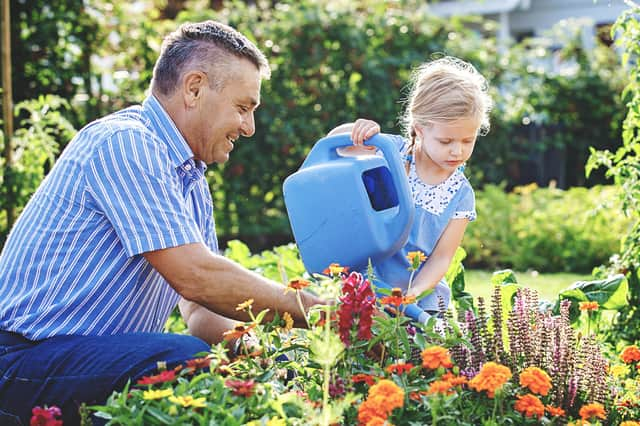Top 10 jobs to do in the garden in August
This article contains affiliate links. We may earn a small commission on items purchased through this article, but that does not affect our editorial judgement.


Green-fingered experts at GardeningExpress.co.uk have put together essential tasks to carry out in the garden during August which include pruning, harvesting and looking out for blight.
n August it’s important to keep your crops hydrated as well as keeping an eye on the general condition of your plants during the heat.
Advertisement
Hide AdAdvertisement
Hide AdTowards the end of the month you may want to start prepping your garden for the colder conditions that we often get during September by doing things like giving your lawn a final mow.
Chris Bonnett, founder of GardeningExpress.co.uk said: “August tends to be the hottest month of the year, although we can never predict what the British weather is going to do, it's important to be prepared to give your plants some really good hydration.
“A lot of people also go on holiday in August and if you are planning on going away then it’s a good idea to give your plants a good water before you go and ask a trusted friend or neighbour to oversee everything while you’re away.
“This is also when you want to harvest your vegetables like sweetcorn and courgettes. Just be sure you store them correctly and make use of them whilst they’re fresh.”
Gardening jobs for August
1. Begin pruning
Advertisement
Hide AdAdvertisement
Hide AdKeep on top of pruning once summer-flowering shrubs have fully blossomed, ensuring plants are kept under control. Fruit trees, such as apples and pears, should be pruned once they are trained, and remain in the sunlight for further ripening. Plants such as wisteria should be pruned regularly to keep under control, and lavender should be pruned for it to remain compact and bushy.
2. Start harvesting
August means that vegetables, such as courgettes and sweetcorn, can now be harvested. Lift up potatoes to make summer salads; remembering to store them in a hessian bag to allow darkness and ventilation. Runner beans can be regularly harvested to allow new pods to grow and prevent the beans from becoming stringy.
3. Remove deadheads
Remove deadheads to encourage new flowers to develop and to avoid unsightly gardens. Concentrate removing deadheads from perennial plants – such as dahlias and lilies – to promote an ongoing show of blossoms in the garden. To remove deadheads simply pinch the stem below the faded flower with your finger and thumb.
4. Cut and dry herbs
The late summer month means cutting herbs such as rosemary and sage. Remember to freeze any leftover herbs to use in dishes and drinks over the coming months. Dry out herbs such as dill and caraway in the garden (away from the direct sunlight). Promote the growth and survival of the winter frost, for perennial herbs like oregano and thyme, by simply trimming them.
5. Watch out for blight
Advertisement
Hide AdAdvertisement
Hide AdEnsure to keep an eye on blight throughout August, especially on tomatoes and potatoes. Blight on tomatoes begins in large brown spots on the stems. Once you see this, pull off the infected plants. For potatoes, blight appears in small dark patches on the edge of the potato leaves. Immediately cut off the top growth to prevent the infectious blight from spreading, then wait a fortnight before harvesting them.
6. Mow the lawn and trim hedges
In August it is important for a final trim of all hedges before they stop growing over winter. Cut the top of the hedge last, and rake away fallen leaves and twigs for a fresh garden. For lawns, do not use high nitrogen fertiliser as this only encourages growth, which will be harmed by the upcoming autumn weather. The late summer means a slower lawn growth, so ensure that lawn mowers are set to a higher cut.
7. Prepare before going on holiday
August often means summer holidays away from home – but it is important to not neglect your garden. Ask friends, family, and neighbours to water plants and flowers, and move potted plants into the shade. If holidaying for a longer period of time, consider installing an automatic watering system whilst away, for both outside plants, and drip irrigation for greenhouses.
8. Regular watering is essential
Watering is fundamental to a blooming and flourishing garden throughout the summer heat. A healthy garden requires frequent watering in August. Top up water features and bird-baths regularly, and water fruit and vegetable plants, daily. When watering, aim directly at the root to avoid dry soil caused from the heat.
9. Greenhouse humidity and ventilation is crucial
Advertisement
Hide AdAdvertisement
Hide AdTo prevent damaging plants by overheating, ventilate the greenhouse by opening vents and doors on August’s warm summer days. To further look after delicate plants from overheating, consider using blinds or shade paint in the greenhouse. Increase the humidity of the greenhouse during the hot weather by dampening the greenhouse by pouring water across the floor each day.
10. Plan for the coming months
Plan winter gardens whilst spending time outdoors in the sun. Plant bulbs such as nerines and colchicums ready for autumn. Prep in time for colder months by planning out garden borders and vegetable patches. In August, plant vegetables such as broccoli and cabbage to ensure they are ready for winter harvesting.